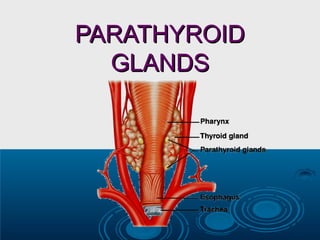PTH stimulates bone resorption and calcium reabsorption in the kidneys to increase blood calcium levels. It also indirectly increases calcium absorption in the intestines by activating vitamin D. Calcitonin has opposing effects, inhibiting bone resorption and decreasing blood calcium. Together, PTH and calcitonin work to maintain tight homeostasis of blood calcium levels. Disorders occur when this balance is disrupted, such as rickets/osteomalacia from vitamin D deficiency or hyperparathyroidism from a PTH-secreting tumor.
















































